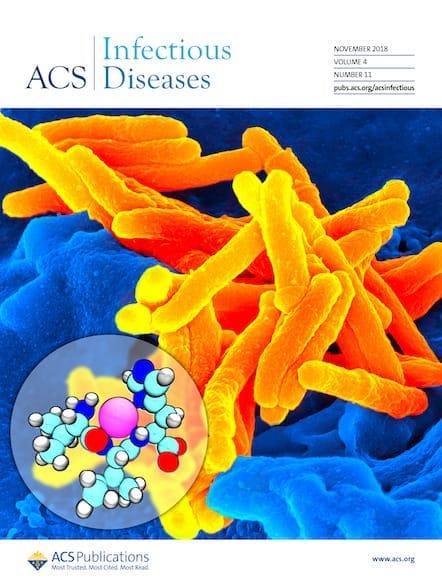The ACS Infectious Diseases Young Investigator Award and the ACS Division of Biological Chemistry recognize outstanding young investigators in the infectious diseases field who are within ten years of their last training experience or at the Assistant Professor level. The 2020 awardees are: Luiz Pedro de Carvalho – The Francis Crick Institute Rushika Perera – Colorado State […]

The ACS Infectious Diseases Young Investigator Award and the ACS Division of Biological Chemistry recognize outstanding young investigators in the infectious diseases field who are within ten years of their last training experience or at the Assistant Professor level. The 2020 awardees are:
- Luiz Pedro de Carvalho – The Francis Crick Institute
- Rushika Perera – Colorado State University
- Cesar de la Fuente – University of Pennsylvania
As winners of the awards, de Carvalho, Perera, and de la Fuente will each receive a plaque, an award of $1,000, and up to $500 in travel reimbursement to attend the fall 2020 ACS National Meeting & Exposition in San Francisco and present at an ACS Division of Biological Chemistry symposium in their honor.
I got the chance to chat with the award winners; read on to find out more about them:
Rushika Perera
How did you get into your field of study?

I got into the field of Systems Biology (specifically metabolomics) soon after my post-doctoral studies. It was a really young field then. No one was really doing metabolomics, as they were mostly focused on transcriptomics and proteomics. I really wanted to look at metabolic changes that viruses induced in their hosts to hijack the host environment for their benefit. It was clear to me that the host environment was being changed significantly by these viruses because when you look at infected cells, their membranes looked so different from uninfected cells. Membrane changes meant that lipids were being altered, and so I realized we needed to look at lipid metabolic pathways. This realization started me on the path I have now taken for the last 10 years, discovering the incredible ways viruses alter our intracellular metabolism to win over the host.
What is the most exciting discovery you have made in your career so far?
That when viruses infect mosquitoes, they alter the mosquito metabolome so significantly to benefit their replication, but do not seem to make the mosquito sick. Also, different viruses such as Zika, dengue, and chikungunya, alter the mosquito metabolome so differently. This provides evidence that they can infect the same mosquito (co-exist) and not have to compete with each other to be transmitted. This was mind-blowing to me.
What are you looking forward to most about your research?
I am very excited to move this field forward and to utilize metabolism as a way to choke virus replication in both the human host and mosquito vector. Most drugs or inhibitors are metabolites. So using these metabolites to divert metabolic pathways to interfere with virus infections (starve the virus of necessary nutrients) is a promising avenue for intervention. Specifically, we can re-purpose many drugs that are already on the market that are used for metabolic diseases such as diabetes, metabolic syndrome, etc., and use them as antivirals – we will only need to use them for a very short period of time to reduce virus replication and give the immune system a chance to overcome the infection.
Cesar de la Fuente
How did you get into your field of study?

I have always been fascinated by the world around me and have cared deeply about helping others. I have had the opportunity to learn principles from different disciplines. I did my Ph.D. at the University of British Columbia. I focused on understanding the underlying principles that drive biological systems. My long-term goal was to 1) understand, 2) control, and 3) computerize these systems. I turned my attention to the bacteria, the simplest living organisms and the first to inhabit Earth, and to proteins, the nanomachines that are the workhorses of life. During this time, I investigated and learned about the different mechanisms used by bacteria to become harmful and built in the lab minimalistic proteins called antimicrobial peptides to counter them. I became fascinated by the possibility of developing novel antibiotics to help save lives.
After my Ph.D., I moved to MIT, arguably the mecca at the time for converging synthetic biology and computer science concepts for technology development. I decided to integrate these disciplines to try to provide solutions to the global antibiotic resistance crisis. My first goal was to achieve precise control over molecules. Soon we made progress in understanding, at a molecular level, the structure-activity relationships of antimicrobial peptides (Nature Commun Biol, 2018). We also created algorithms capable of discovering peptide antibiotics in proteomes (ACS Synthetic Biology 2018). The next paradigm shift would be to train computers to generate such molecules. We focused on developing antibiotics by means of computers that worked in animal models (Nature Commun 2018).
I was then recruited by the University of Pennsylvania as a Presidential Assistant Professor. I currently lead the highly interdisciplinary Machine Biology Group where we are engaged in a quest to develop the first class of computer-made drugs to replenish our current antibiotic arsenal.
What is the most exciting discovery you have made in your career so far?
The discovery that antibiotics could be both discovered and designed using computers. My lab is motivated by the notion that the natural world may have run out of inspiration, in terms of its ability to provide us with novel life-saving antibiotics. This assumption is based on the fact that, for decades, we have been unable to discover truly novel classes of antibiotics from natural sources. We believe that the next generation of antibiotics will likely come from machines through their ability to explore previously unexplored regions of sequence space and model synthetic molecules. Our work has shown that computational tools can be used to bring much-needed innovation to antibiotic discovery.
Recently, we also repurposed a highly toxic wasp venom peptide into a viable antibiotic with anti-infective activity (Nature Communications Biology 2018), demonstrating that toxicity could be eliminated from such molecules.
In previous work, we designed new classes of synthetic peptides that are highly effective against biofilms and antibiotic-resistant bacteria in vitro and in vivo. We have also generated peptides that potentiate conventional antibiotics, discovered synthetic peptides that sensitize drug-resistant bacteria to antibiotics, and built host-targeting immunotherapies. Moreover, we designed mirror-image (D-enantiomeric) peptides that are resistant to enzymatic degradation by proteases and therefore have a longer half-life and are more stable than natural peptides. These modified peptides, which are more suitable for animal testing, protect against otherwise lethal bacterial infections in several animal models, thus demonstrating clinical potential.
What are you looking forward to most about your research?
From a scientific standpoint, I am excited about creating the first class of computer-made antibiotics. From a more personal perspective, working towards this goal alongside a team of incredibly driven, passionate, creative, and diverse individuals is truly a dream come true. It is a privilege to work with such incredible people in a special and inspiring place like the University of Pennsylvania.
Luiz Pedro de Carvalho

How did you get into your field of study?
I knew I would be a scientist since I was eight years old. Carl Sagan’s Cosmos had a profound effect on me, even though physics was clearly not my call. I studied pharmaceutical sciences at the Federal University of Rio Grande do Sul in Porto Alegre – Brazil and after a brief MSc degree at the same university, I moved to the USA for my Ph.D. I studied mechanistic enzymology under John S. Blanchard, at the Albert Einstein College of Medicine, in New York City. Although enzymology truly expanded my perception of chemistry and biology, I felt I need to learn some microbiology. I joined Carl Nathan’s lab at Weill Cornell Med School, also in NYC, and had the privilege to work in a big group focused on Mycobacterium tuberculosis. During my postdoc at Cornell, thanks to a faculty member, Kyu Rhee, I could work on the first applications of liquid chromatography-mass spectrometry metabolomics to M. tuberculosis enzymology, physiology, and pharmacology. I trained on how to work with M. tuberculosis as planned but also had the privilege of learning how valuable and accessible mass spectrometry had become.
What is the most exciting discovery you have made in your career so far?
I was fortunate to find a position at the National Institute for Medical Research in London, U.K., which is now part of the Francis Crick Institute. During my independent career, I have focused on three themes: (i) functional genomics and enzymology, (ii) host-relevant M. tuberculosis metabolism, and (iii) mechanistic antibiotic research. On antibiotics, we significantly expanded our understanding of how a small molecule natural product antibiotic really works. D-cycloserine (DCS) is a cornerstone drug used to treat drug-resistant tuberculosis. It was a tough decision to work on it as a junior faculty as several outstanding scientists such as Richard Silverman and Christopher Walsh had worked on it. However, nearly all the work is done on DCS, and its two targets employed enzymes from model bacteria such as E. coli. Using alanine racemase and D-Ala:D-Ala ligase from M. tuberculosis and other species, we published a series of studies that led ultimately to a revision of the mechanism of action and resistance to this drug. During these studies, we discovered that alanine racemase, one of the DCS targets, is also a resistant determinant. To our knowledge, this is the first case of target mediated antibiotic inactivation.
What are you looking forward to most about your research?
I think we have made important discoveries in the three areas we have focused on. I am super excited about a number of ongoing projects in the lab now. For now, the plan is to continue to investigate the biochemical and metabolic basis of human tuberculosis, from the bug side. I am indebted to my family, colleagues, mentors, and collaborators, and to the Wellcome Trust and the Francis Crick Institute for allowing me to carry out bold, imaginative blue-sky research on the world’s most important bacterial pathogen.
